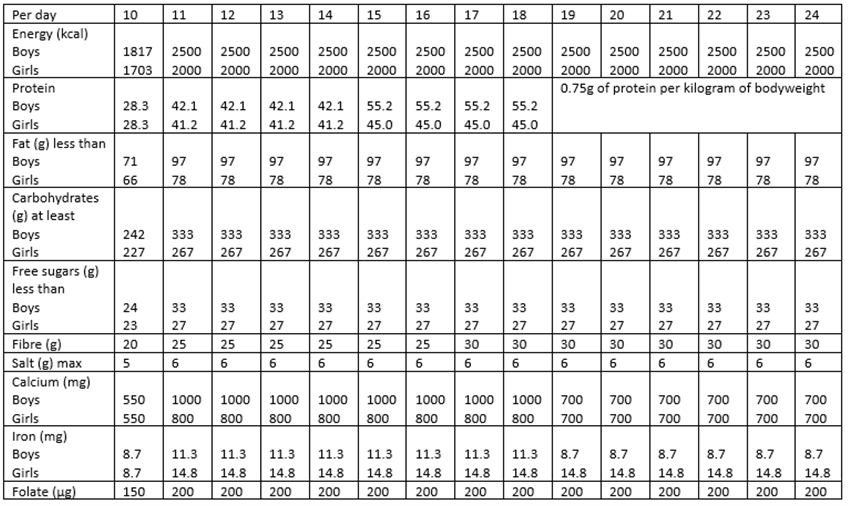NHD Paediatric Hub
Feeding our teenagers
This article seeks to explore the nutritional needs of teenagers and flag some of the barriers to achieving the recommendations. Adolescence is defined by the World Health Organisation as a person between the ages of 10 and 24 years.(1) For this article, the focus will be on those in secondary school age 11-18.
The teenage years are often characterised by parents as a time of rebellion, hormones and disconnection. A lot changes in this stage of life both internally for the teenager and in the way they interact with the environment and those around them. Teenagers can sometimes fall between the gap in health promotion and treatment with services and information either being aimed at children or adults.(2) Although this is a transition time, it is vital this group gets nutrition support as habits and dietary-related conditions track into adulthood.(34)

Nutritional requirements
The nutritional requirements increase in the teenage years. SACN dietary reference values for energy, protein, fat and carbohydrate for example increase dramatically between age 10 and 11 and then remain the same throughout adolescence (except for protein which increases again at age 15) as seen in Table 1. These Dietary Reference Values (DRVs) are of course not the requirements for individual teenagers with needs being linked to size, activity, growth and more, but they give a view into the change that comes at this age. There is also a significant difference between boys and girls in DRV, again this is an average but shows that it may be necessary to have different information for boys and girls.

GROWTH
Growth is a major reason for the increased requirements. This is particularly important when it comes to calcium (as well as other nutrients needed for bone growth). Peak bone mass is reached in later adolescence and this is a predictive factor in the risk of osteoporosis in later life. A 10% increase in peak bone mass would reduce osteoporotic fracture risk in older adults by 50%.(5)
FOLATE
As tissue growth is rapid at this age, folate requirements increase dramatically at age 11 too. Folate is needed for DNA and RNA synthesis, production of red blood cells as well as protein metabolism, all crucial at this age. The folate requirements do not vary with gender unlike iron DRVs which increase in both genders at age 11 due to the increase in growth and, therefore, haemoglobin synthesis. However, the increase is greater in girls due to blood loss during menstruation. Girls’ iron requirements remain high until menopause, whereas the DRV for boys reduces at age 19 when growth is either complete or almost complete.
IRON
According to the National Diet and Nutrition Survey (NDNS) data, 49% of girls aged 11 to 18 years had low iron intake (below the LRNI).(6) Iron is clearly a nutrient which needs additional focus for this group. With the rise in veganism (350% increase since 2006) and 42% of vegans being between 15 and 32 years old,(7) specific care must be taken to plan a diet which includes sufficient calcium, vitamin B12, iodine and iron.
SUGAR AND SALT
Within public health, there has been much focus on reducing salt and sugar and increasing fibre intake. The maximum amount of free sugar and salt recommended is higher at age 11 than at age 10 but this does not mean teenagers should be encouraged to have more, rather their bodies can cope with a little more. The NDNS (2016/17-2018/19) found that children aged 11-18 had on average 12.8% of their energy coming from free sugars, more than twice the 5% recommendation.(8)
FIBRE
Fibre requirements increase at age 10 and then again at age 17. Like adults, teenagers in the UK are not consuming enough fibre (16g on average in the 11-18 year old age group). Only 12% of 11-18 year olds met the 5-a-day recommendation.(8) There is clearly much more work to be done to improve teenage diets.
Table 1: Nutritional requirements of adolescents (9,10)

School food

Children aged 11-16 are in school 39 weeks of the year, so school food, or food availability around school is important at this age. Secondary schools maintained by the local authority are required to adhere to the School Food Standards. Free schools and academies that are not maintained by the local authority do not.
A Food Foundation report stated that 'only 25% of schools in England were estimated to be meeting the School Food Standards – compliance of the rest is unknown'.(11) Primary school meals tend to be paid for in advance by the parents whereas secondary school meals tend to be more café style, with teenagers holding the purse strings. This means the food choice of teenagers tends to dictate what is on the menu as sales figures drive the food being served.
School meal quality varies but Parnham et al reported ultra-processed food was high – 64% in school meals, although it was higher still in packed lunches.(12) A review published in 2023 by the same group on the state of school food details many of the challenges around school food including funding, procurement and eligibility of free school meals and goes into far more detail than this article can.(13)
It is not just food served on the premises that will influence a teenager’s diet on a school day. Before and after school, teenagers have access to outlets around school. Some schools also allow children out during the day.
There has been a lot of work, and press, around restricting fast food outlets close to schools. 50% of local authorities in England use planning guidance to restrict new fast-food outlets. However, in a recent study in Newcastle, no statistical difference in fast-food outlets in exclusion zones was found compared with a control, possibly due to the lack of change in the food environment – areas may already be saturated with outlets and these restrictions have focused on new licences.(14)
So what is influencing teenage food choice?
As teenagers become more independent, parental control decreases. Daly et al who have done extensive work in this area on Irish teenagers note that social desirability, social norms, taste, price and convenience are leading factors.(15) In addition to this, poor body image and body dissatisfaction are driving choice,(16) as well as trends such as veganism. In an international study of teenagers (which excluded the UK but included countries on every continent) found that high levels of body dissatisfaction, poor dietary intake, poor nutrition knowledge but particularly shopping and cooking skills, social media, family and peer influence, taste, finances, environment, gender barriers, and eating a main meal in front of the TV or computer were all factors.(17) Marketing also plays a big role in choice; a topic which Bite Back 2030 seeks to change.
Being aware of these factors when working with teenagers directly or when working with families of teenagers is essential. Whilst education is important, this is often not the driving factor when it comes to food choice. Ultimately teenagers need the right nutrition to thrive, so the focus in health promotion needs to be on ensuring that the food they need to be eating is tasty, affordable and convenient, that social media and marketing point them in the right direction, and that social desirability is looked at when creating environments where a healthy balanced diet is promoted.
This article has only scratched the surface on this topic, more needs to be done to support work and research into improving the diets of teenagers.

Twitter: @aliyaporter
Facebook: @porter_nutrition
www.weaning.co.uk
www.porternutrition.co.uk
Aliya Porter, RNutr
Freelance Registered Nutritionist
References
- Craigie, AM, Lake, AA, Kelly, SA et al. (2011) Tracking of obesity-related behaviours from childhood to adulthood: a systematic review. Maturitas 70, 266–284 https://www.maturitas.org/article/S0378-5122(11)00296-9/fulltext
- Neumark-Sztainer, D, Wall, M, Larson, NI et al. (2011) Dieting and disordered eating behaviors from adolescence to young adulthood: findings from a 10-year longitudinal study. J Am Diet Assoc 111, 1004 https://www.sciencedirect.com/science/article/abs/pii/S0002822311004251
- Sawyer, SM, Azzopardi, PS, Wickremarathne, D et al. (2018) The age of adolescence. Lancet Child Adolesc Heal 2, 223–228 https://www.thelancet.com/journals/lanchi/article/PIIS2352-4642(18)30022-1
- Care Quality Commission (2014) From the pond into the sea Children’s transition to adult health services. https://www.cqc.org.uk/sites/default/files/CQC_Transition%20Report.pdf.
- Cummings SR, Black DM, Nevitt MC, et al (1993) Bone density at various sites for prediction of hip fractures. The Study of Osteoporotic Fractures Research Group. Lancet. 1993;341:72–5 https://pubmed.ncbi.nlm.nih.gov/8093403/
- Public Health England (2020) https://www.gov.uk/government/statistics/ndns-results-from-years-9-to-11-2016-to-2017-and-2018-to-2019/ndns-results-from-years-9-to-11-combined-statistical-summary#:~:text=Forty%2Dnine%20per%20cent%20of,and%202%25%20of%20older%20women.
- Marsh (2016) The rise of vegan teenagers: 'More people are into it because of Instagram'. The Guardian. https://www.theguardian.com/lifeandstyle/2016/may/27/the-rise-of-vegan-teenagers-more-people-are-into-it-because-of-instagram
- British Nutrition Foundation (2020) Key findings from NDNS report for years 9 to 11 (combined) https://www.nutrition.org.uk/news/2020/key-findings-from-ndns-report-for-years-9-to-11-combined/
- PHE (2016) Government Dietary Recommendations Government recommendations for energy and nutrients for males and females aged 1 – 18 years and 19+ years https://assets.publishing.service.gov.uk/media/5a749fece5274a44083b82d8/government_dietary_recommendations.pdf
- British Nutrition Foundation (2021) Nutrition Requirements https://www.nutrition.org.uk/media/nmmewdug/nutrition-requirements.pdf
- Goudie S & Hughes I (2022) The Broken Plate. London: Food Foundation
- Parnham JC, Chang K, Rauber F et al. (2022) The ultra-processed food content of school meals and packed lunches in the United Kingdom. Nutrition 14, 2961 https://pubmed.ncbi.nlm.nih.gov/35889918/
- Parnham, J. C., Millett, C. and Vamos, E. P. (2023) “School meals in the UK: ultra-processed, unequal and inadequate,” Public Health Nutrition, 26(1), pp. 297–301. https://spiral.imperial.ac.uk/bitstream/10044/1/101015/10/school-meals-in-the-uk-ultra-processed-unequal-and-inadequate.pdf
- Brown, H., Kirkman, S., Albani, V., Goffe, L., Akhter, N., Hollingsworth, B., von Hinke, S., & Lake, A. (2021). The impact of school exclusion zone planning guidance on the number and type of food outlets in an English local authority: A longitudinal analysis. Health & place, 70, 102600. https://doi.org/10.1016/j.healthplace.2021.102600 https://www.ncbi.nlm.nih.gov/pmc/articles/PMC8361782/
- Daly AN, O'Sullivan EJ, Kearney JM. Considerations for health and food choice in adolescents. Proc Nutr Soc. 2022 Mar;81(1):75-86. doi: 10.1017/S0029665121003827. Epub 2021 Nov 29. PMID: 35039094. https://www.cambridge.org/core/journals/proceedings-of-the-nutrition-society/article/considerations-for-health-and-food-choice-in-adolescents/7E62D46D3D90D55B45D66A120C4C27D2
- Canadian Paediatric Society Position Statement (2004) Dieting in adolescence. Paediatr Child Health 9, 487. https://academic.oup.com/pch/article/9/7/487/2648606
- Fleming, C. A., De Oliveira, J. D., Hockey, K., Lala, G., Schmied, V., Theakstone, G., & Third, A. (2020). Food and Me. How Adolescents Experience Nutrition Across the World. A Companion Report to The State of the World's Children 2019. https://doi.org/10.26183/26f6-ec12 https://researchdirect.westernsydney.edu.au/islandora/object/uws:58028
